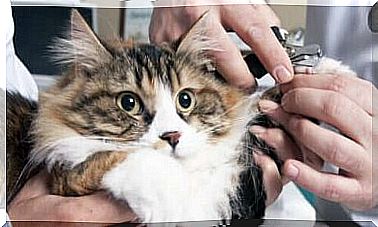Cat-pig Syndrome: What Is This Allergy

Cat-pig syndrome is very rare and for this reason there is not much research on the subject. Basically, it has to do with people allergic to cats and also to pork. This is what is called ‘cross allergy’.
Until now, there are very few records about this health problem. The cat-pig syndrome was first named in 1994. A formal description was made only in the late 90s.
The manifestations of this disease are similar to those of other allergies. They range from skin reactions and respiratory problems to anaphylaxis. Therefore, the cat-pig syndrome should receive the attention it deserves.
A curious background
Before the cat-pig syndrome was described, Cisteró-Bahíma made a reference to one of these cross allergies, which is curious. It was the case of a 39-year-old woman who began to show symptoms of allergy to cats.
Upon examining her medical history, it was discovered that, during her childhood, she suffered from oral itching when consuming rabbit meat. As an adult, she also had allergic reactions to horse meat. A year before that, she had a hamster in her house.
This led to the conclusion that she was ‘cross-reactive’. In other words, I had allergic reactions to various allergens. The commonalities were studied and then it was concluded that it could all be caused by the presence of a common protein in the epithelium of some animals and in the meat of others.

Causes of cat-pig syndrome
Cases of allergies to mammalian meat are extremely rare. However, in recent years, cases of this type have been reported, mainly in Europe and North America.
Everything seems to indicate that it is due to a hypersensitivity to serum albumin protein. This protein is present in cats and is very similar to the serum albumin in pork. This would explain why some people are allergic to an animal and a food at the same time.
In mammals, serum albumin is present in various tissues. Also in the flesh, on the skin and in different types of secretions. The mechanism by which these intolerances operate in humans is not fully understood.
Characteristics of the cat-pig syndrome
What little is known about the cat-pig syndrome indicates that cat allergy usually appears first. It is common for this to happen during childhood. Meanwhile, pork allergy usually manifests itself in adulthood.
In addition, it has been established that allergy to cats’ epithelium generally produces respiratory symptoms. Pork intolerance, in turn, has the characteristics of a food allergy. Other cases of cross-reactions, such as the cat-lamb syndrome or the horse-hamster syndrome, have also been detected.

Some of the characteristics of the cat-pig syndrome are as follows:
- Reactions most often appear after consumption of undercooked, raw, dried or smoked meat.
- An allergic reaction is less likely when the pork is well cooked.
- The first symptoms of allergy appear 20 to 40 minutes after eating the pork. In other meat allergies, the reaction takes several hours to manifest.
- The reaction occurs with all foods of pork origin, such as sausages, salami, ham and other sausages.
Other interesting data
There are some data that allow us to infer that the cat’s serum albumin intolerance tends to gradually disappear over time. In these cases, there is also a remission of symptoms when consuming pork. However, if contact with cats continues, intolerance to pork is also maintained.
It is important to seek as accurate a diagnosis as possible to establish the presence of the cat-pig syndrome. This diagnosis must be supported by relevant skin tests and blood tests. Specific immunoglobulin E (IgE) should be determined to avoid other allergies.
In general, it is recommended that people with this type of problem avoid eating pork. However, it is also recommended that they have an epinephrine autoinjector for emergencies. Some food compositions do not allow detecting that they contain pork or any of its derivatives.









